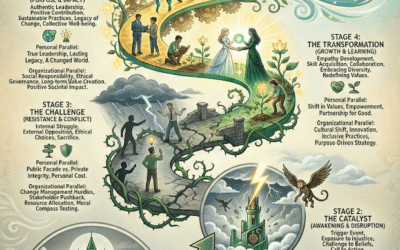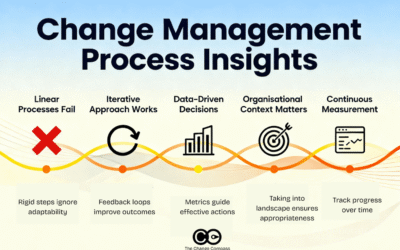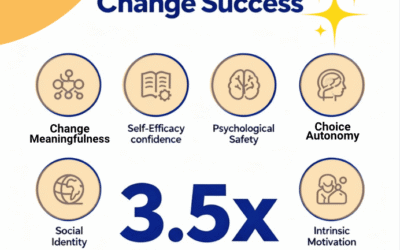Most of us are still in lockdown or partial lockdown with Covid. At the same time, many countries are in the process of lifting restrictions and resuming normal business and social activities. In the US President Trump pushes to reopen the economy and phase out the coronavirus task force. In Italy the restriction have just been lifted. Here in Australia the government is planning a gradual return to business.
What is going to happen after we return to work? What would the new world look like post Covid or transitioning away from Covid?
As change practitioners we have a unique role to play in helping to support change and help the organization to adjust to the new norms. We are impacted like everyone else and yet we need to lead others to transition through the change. We are after all change leaders.
Here are some of the likely realities of the post-Covid world after we return to ‘the norm’ after the Covid lockdown:
1. Continued virtual working
It is likely that organizations will be cautious and phase the gradual ‘return to work’ process so as to avoid any potential of re-infection. Some are already in the 1 week in 1 week out arrangement to reduce the number of employee on the same floor. Others may selectively organise the return to work on a group by group or team by team manner, again to control the density level of employees per area.
Employees at Google and Facebook were told that they could continue to work from home until next year. For Amazon employees it is until October. There is also quite a number of large financial services firms that will continue virtual working.
As a result, the days of virtual working will not go away any time soon. As significant numbers of employees continue to work from home, so will the need to continually engage our stakeholders virtually. This includes engaging impacted stakeholders, designing effective leadership communication, sensing change readiness, and measuring change embedment. Do all of these virtually.
There is research to suggest that video conferencing over an extended period of time is cognitively very taxing for people. The attentiveness and focus required to go through a whole day of video conference meetings can add toll to the health and well-being of employees. Supporting employees to build effective virtual working habits is critical.
2. Employees who want to remain WFH
There are those who are stressed working from home and struggle with looking after kids and juggling meetings. They as a result cannot wait to return to the office when schools are closed.
However, there are also those who have enjoyed working virtually immensely.
Catherine lives in the mountains 2 hour away from the office. Every day that she works from home she is saving 4 hours per day in commuting time. She gets to spend more time with her husband and her cat and she can easily open the door onto her balcony, overlooking the forest during her virtual meetings. She gets to cook more and can move around the house as needed so that she is not disturbed by her husband, who is also working from home.
Mark is also quite reluctant to return back to the office. He is finding that he is significantly more productive as there is no one approaching him to chat about the weekend, and all the various chit chat that happens within an office environment. He gets to focus on his deliverables without the office noises. Between meetings Mark can fit in his workouts at the park or at home. He definitely feels that he has a much better work-life balance.

3. Cost cutting and Zero based budget
New articles abound that we are entering an unprecedented period of economic depression, the worst since the second world war for Europe and worse than the financial meltdown in 2008 for the US. What this means is that most business will be impacted in a major way. Many businesses have already closed shop whilst others are belt-tightening or planning to in order to manoeuvre the uncertain future that is post Covid.
There are those businesses that have had most of their revenue wiped out, including retail, entertainment and food & beverage industries. There are also ramifications for businesses that support other businesses that are impacted by Covid, such as manufacturing or aerospace.
Companies may resort to a zero-based budget approach of prioritising the basics of cost management in order to survive. According to Wikipedia zero-based budget (ZBB) “is a method of budgeting in which all expenses must be justified and approved for each new period”. This is essentially a reset of cost to careful consider the most critical cost required to sustain the business. In this system, costs are grouped and measured against previous results and current expectations, enabling management to allocate funds by current need instead of by historical expenditures.
As change practitioners we need to prepare for rounds of cost containment or cutting of the initiatives that we are involved in. Expenditure will be tightly controlled. We need to consider ways in which we can continue to carry out change work with minimum additional expenditure.
4. Eventual reduction of commercial real estate utilisation
During Covid organizations have learnt that virtual working does work, even for those who have not experimented with this way of working. In order to save cost, companies will naturally plan to reduce any floor space requirement for those who are soon facing property rental lease renewal. Over time, we will start to see a reduction of commercial property requirement from businesses as organizations down size their office space footage and leverage more on virtual working.
So it looks like virtual working is likely here to stay. As change practitioners we need to continually develop and refine our change approaches in engaging our stakeholders virtually. There are various digital tools that can help fortunately. Some tools are designed to measure team engagement using machine learning. Others allow the expression of mood and responses without having to put this into verbal communication. Leverage these tools going forward (as cost permits) to engage effectively in a virtual world.

5. Disruption of initiatives/Re-planning
We need to be prepared for a series of disruptions whether it be ways of working, having to re-adjust change approaches, tightening expenditure, or having our change initiatives altered. Some initiatives will get pushed back, cancelled or moved forward. New initiatives or even restructuring exercises may emerge on top of existing initiatives. We may be asked to deliver more with less resources.
How do we manage our existing portfolio of change initiatives within this environment? We need to be agile and flexible to anticipate and work with various initiative changes. It could be that business capacity constantly shifts as a result of staff moving back to the office, or that teams become restructured therefore disrupting the initiative roll out.
Utilise visual management to analyse and foresee implications of shifting initiatives. The Change Compass has a scenario planning feature that allows you to visualise the picture of new scenarios when various initiative timelines are shifted. For more details please listen to our webinar on re-planning during Covid.
Key considerations when shifting initiatives include:
- Subsequent implications on business capacity (will we create another peak change volume later in the year?)
- Potential dependencies of projects in the sequence of the roll out
- Overlap with any planned business black-out periods or periods of high work volumes (such as customer contact volumes)
- Implications on benefit realisation in relation to business targets
- Business readiness due to transition back to the office
- Initiative resources and bandwidth available to carry out any shifts in implementation timeline
- Communication implications of the shifted initiatives that will be delivered to the same stakeholder group






